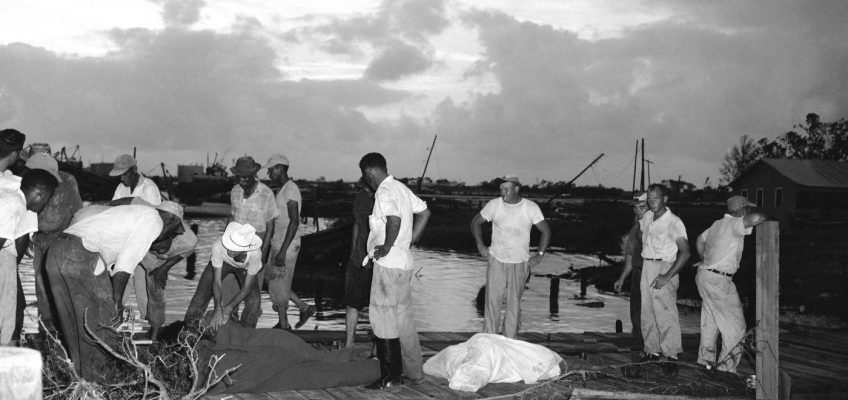Caroline Lowe was working at WCCO-TV in Minneapolis in 1995 when Jodi Huisentruit, a Mason City, Iowa, TV news anchor, disappeared.
The news rocked the WCCO newsroom, Lowe said.
Former WCCO-TV reporter Caroline Lowe is traveling to Mason City for an event to mark the 30th anniversary of Jodi Huisentruit’s disappearance. She plans to bring a stone with the word “Hope” engraved on it, a gift from Patty Wetterling. (Courtesy of Caroline Lowe)
“She was a Minnesota gal. She was one of our own,” said Lowe, who now works as an independent journalist in northern California. “She was going to work one morning to do what we do, and until we know otherwise, I consider her somebody who was snatched on her way to do her job. This person stopped her from doing her job, stopped her from living a life, but we’re not going to stop looking for them and seeking answers. It’s, like, how do we walk away from that?”
Lowe has spent decades working to solve the cold-case mystery. She and other members of FindJodi.com will gather with friends and family members of Huisentruit at 11 a.m. Friday outside KIMT-TV in Mason City to mark the 30th anniversary of Huisentruit’s disappearance.
“It’s time,” she said. “I’ve been doing this for 28 years now. One of my grandkids asked me a couple of years ago, he was about 7 or 8, and he said, ‘How long are you going to do this? When are you going to stop?’ His sister jumped in and said, ‘Never. She can’t.’
“You know, I was like, ‘Oh my God, I hope it’s not going to be forever.’”
30 seconds, 30 years
Huisentruit overslept on the morning of June 27, 1995.
When Amy Kuns, an assistant producer at KIMT-TV, called to check on her, the 27-year-old native of Long Prairie, Minn., said she had just gotten up and would be at the station in time for her 6 a.m. broadcast.
It was the last anyone heard from her.
Authorities believe someone grabbed Huisentruit shortly after 4 a.m. as she went to her red Mazda Miata in the parking lot of the Key Apartments in Mason City. Neighbors said they heard a scream about that time, and a passerby reported that he saw a white van in the parking lot.
Police found Huisentruit’s red high heels, blow dryer, hair spray and earrings strewn across the lot. Her bent car key lay on the ground near the Miata, and police believe she was unlocking her car door when she was attacked from behind.
An unidentified partial palm print was found on her car, but there were no other substantial clues.
“She was 12 steps from her apartment building,” Lowe said Thursday as she drove to Mason City. “She was basically just outside the front door. We walked it. From the time she left her apartment on the second floor, walked down the steps, and went to her car, it was 30 seconds. And now it’s been 30 years.”
Thousands of tips
Mason City police have received thousands of tips over the years, and they continue to come in, especially around this time of year, said Police Chief Jeff Brinkley.
“I think that at different points, people reach out for different reasons,” he said. “In most cases it’s, ‘Hey, I think this is nothing, but I want you to have it.’ Particularly for people in the community, they feel like it’s their chance to do their part to help — just in case it’s something that we can use.”
Special Agent Ryan Herman, of the Iowa Division of Criminal Investigation, was assigned to the Huisentruit case in the fall of 2021. He said he generally gets half a dozen to two dozen tips a week, but he’s already fielded 279 tips this spring.
“It’s a cliché, but we do hope we get closure for the family,” he said. “I hope we find out where she is or what happened to her. Answering those questions for the family is important.”
Herman grew up in southern Minnesota and was 11 when Huisentruit disappeared; his grandparents, who lived in Albert Lea, used to watch her on the morning news.
“I remember when it happened,” he said. “Personally, I do think it will be solved. There’s still an interest in the case. I don’t know that we’ll get the result that we want, but I do think it’ll be solved at some point. I think there’s an answer for every case.”
‘Had to do it’: St. Paul Park man to receive Carnegie Medal for fiery St. Paul rescue
Lawmaker shooting suspect’s wife: Violence ‘a betrayal’ of Christian faith
With 16 Pride flags vandalized in St. Paul, neighbors responding with more flags
Funeral set for Metro Transit officer who drowned in White Bear Lake
Motorist charged with hitting maintenance scissor lift inside North Shore highway tunnel
Herman credits Lowe for helping keep the case in the public spotlight.
“I have more phone-call conversations with Caroline than I do my own mother,” he said. “She sends me stuff throughout the week, and then she’ll touch base with me, ‘Hey, did you get this? What do you think about this?’ She’s kind of a bulldog. She doesn’t let up.”
Lowe graduated with a bachelor’s degree in law enforcement from Metropolitan State University in St. Paul and earned a master’s degree in police leadership from the University of St. Thomas in St. Paul. She has a private-investigator license in California, spent eight summers as a patrol officer at the Minnesota State Fair and graduated in 2010 from the FBI Citizens’ Academy in Minneapolis. She also attended the Petaluma, Calif., Police Department’s Citizens’ Academy.
‘Incredibly grateful’
Lowe’s experience in law enforcement and the media has been invaluable, according to Huisentruit’s family members.
“I’ve said to Caroline so many times, and I will continue to say it, ‘We’re never going to be able to say “Thank you” enough, but we’re going to try,’” said Huisentruit’s niece, who asked not to be named. “We’re just incredibly grateful.”
The FindJodi.com team has released an updated flyer and created a new billboard to mark 30 years since Jodi Huisentruit’s disappearance. (Courtesy of FindJodi.com)
Lowe helped the niece, who lives in St. Paul, launch the separate “Jodi’s Hope” Facebook page in December. This page is described as a “dedicated space to hear directly from Jodi’s family” and is meant to “clarify erroneous information that has been presented regarding Jodi and/or the case.”
Lowe “has just been a great source of information, a great sounding board,” the niece said. “Just somebody that I can turn to to say, ‘What do you think of this? Or how does this look?’ She’s just great about keeping me in the loop about things, and she just has such a great heart.”
The niece, who grew up in Sauk Centre, said it was she who answered the phone when the Mason City Police Department called to report that her Aunt Jodi, who was her godmother, was missing.
The news was hard to comprehend, she said.
“I knew kids went missing. I knew because of the Jacob Wetterling case that happened in our area,” she said, referring to the 11-year-old boy who was abducted on Oct. 22, 1989, by a masked gunman along a rural road in St. Joseph, not far from his home. “I knew about that situation, but I just couldn’t comprehend that an adult would go missing, and so in my head, I didn’t think it was that serious. I just thought, you know, she got a flat tire and can’t get in touch with somebody.”
“Later that day, when we met up with my grandma, I saw the look on her face, and then I just saw how everybody’s demeanor and face changed, and I knew it was a lot more serious than I was imagining,” she said.
Her grandmother, Imogene Huisentruit, died in December 2024 at age 91.
Jodi Huisentruit was her idol, the niece said. “She was always positive, always upbeat, full of energy,” she said. “She was somebody that I really wanted to be like. She had a great influence in who I’ve become … in who I am as a person, how I treat people.”
The niece said she holds on to hope that the case will be solved.
“Hope is probably the only thing that I’ve got at this point, so I’m always going to hope that it will be solved,” she said. “But, you know, logically, I recognize we’re now at 30 years, and that every year that goes by, it gets harder and harder for that possibility to happen. But I’m still going to hang on to hope that it will.”
‘Holding onto hope’
In conjunction with the upcoming 30th anniversary, FindJodi team member Brian Wise produced a 30-second video, called “30 seconds,” to underscore how fast Huisentruit disappeared, Lowe said. The only sound in the brief video is of a clock ticking for 30 seconds.
The video has been posted on the FindJodi Facebook page and YouTube channel. The group also branched out and posted the video on TikTok, she said.
A new billboard also has been erected near the Mason City Airport. It reads: “30 years. It’s time.”
“This is the third iteration of the billboard,” Lowe said. “We don’t want to become wallpaper. We want Jodi to be present in Mason City. We want people in Mason City to see her until she’s found, so our goal is to just keep putting her up at different places around town.”
Many of the people Lowe has worked with on the Huisentruit case are gone. Retired Woodbury police Cmdr. Jay Alberio died in November 2024; former TV news director Gary Peterson, who co-founded the FindJodi site with news anchor Josh Benson, died in April 2023.
“It’s so sobering,” Lowe said. “So many witnesses have passed away. Memories have faded. That’s one of the biggest challenges. Memories fade, and there’s not a lot of evidence. I mean, this is as tough of a case – it’s tougher than Jacob (Wetterling)’s because at least with Jacob, we had eyewitnesses, right? We don’t have any of that in this case, so it’s tough.”
In 2015, police arrested Danny Heinrich, 53, of Annandale, who later confessed to kidnapping, molesting and murdering the boy.
‘Had to do it’: St. Paul Park man to receive Carnegie Medal for fiery St. Paul rescue
What spaces and places built memories for you, Minnesota? Share them with the North Star Story Map
Music as meditation: Guitars for Vets provides outlet for MN vets
Have a great idea for Stillwater area? You could win $10,000 to make it happen.
A village for vets: New housing for veterans at risk of homelessness takes shape in Eagan
Lowe said she keeps a photo of Huisentruit on her desk next to a photo of Jacob.
Among the items she took to Mason City this week was a stone with the word “Hope” on it – a gift from Patty Wetterling, Jacob’s mother.
“Patty gave me that a number of years ago, before Jacob was found,” she said. “So I’m holding on to that. I’m holding onto hope.”
Jodi Huisentruit gathering
An event to mark the 30th anniversary of the disappearance of Jodi Huisentruit will begin at 11 a.m. Friday outside KIMT-TV, the Mason City, Iowa, TV station where she worked.
The event will be livestreamed on the FindJodi Facebook page and video will be posted on FindJodi’s YouTube channel.




